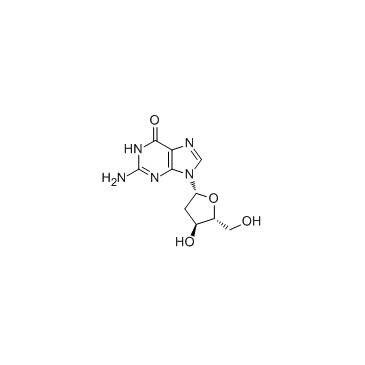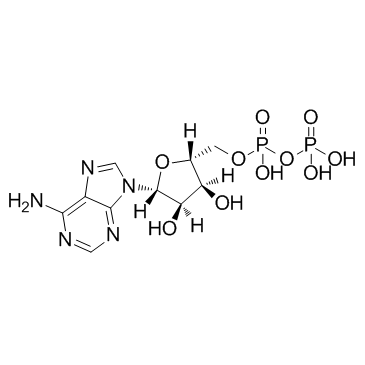2564-35-4
| 中文名 | 2'-脱氧鸟苷 5'-(四氢三磷酸酯) |
|---|---|
| 英文名 | dGTP |
| 英文别名 |
deoxyguanosinetriphosphate
2'-deoxy-GTP 5'-deoxyguanosine triphosphate DGTP LI-SALT deoxy-gtp 5'-DGTP 2'-DEOXYGUANOSINE-5'-TRIPHOSPHORIC ACID, DISODIUM DGTP,LI DGTP,NA2H2 2'-Deoxyguanosine 5'-(Tetrahydrogen Triphosphate) EINECS 219-887-2 |
| 描述 | dGTP(2’-脱氧鸟苷-5’-三磷酸)是一种鸟苷核苷酸,可用于脱氧核糖核酸的合成。鸟苷核苷酸(GDP、GTP、dGDP和dGTP)对8-O-GDP(8-O-GDP)、8-O-dGTP、8-O-GTP和8-O-dGTP的氧化损伤高度敏感[1]。 |
|---|---|
| 相关类别 | |
| 参考文献 |
| 密度 | 2.63g/cm3 |
|---|---|
| 沸点 | 989.5ºC at 760 mmHg |
| 分子式 | C10H16N5O13P3 |
| 分子量 | 507.18 |
| 闪点 | 552.2ºC |
| PSA | 313.96000 |
| LogP | 0.15110 |
| 蒸汽压 | 0mmHg at 25°C |
| 折射率 | 1.904 |
| 储存条件 | -20°C, 密封, 干燥 |
Synonym:DGT Section 2 - COMPOSITION, INFORMATION ON INGREDIENTS
Risk Phrases: None Listed. Section 3 - HAZARDS IDENTIFICATION EMERGENCY OVERVIEW
The toxicological properties of this material have not been fully investigated. Potential Health Effects Eye: May cause eye irritation. Skin: May cause skin irritation. Ingestion: May cause gastrointestinal irritation with nausea, vomiting and diarrhea. The toxicological properties of this substance have not been fully investigated. Inhalation: May cause respiratory tract irritation. The toxicological properties of this substance have not been fully investigated. Chronic: No information found. Section 4 - FIRST AID MEASURES Eyes: Flush eyes with plenty of water for at least 15 minutes, occasionally lifting the upper and lower eyelids. Get medical aid. Skin: Flush skin with plenty of water for at least 15 minutes while removing contaminated clothing and shoes. Get medical aid if irritation develops or persists. Wash clothing before reuse. Ingestion: Do not induce vomiting. If victim is conscious and alert, give 2-4 cupfuls of milk or water. Get medical aid immediately. Inhalation: Remove from exposure and move to fresh air immediately. If not breathing, give artificial respiration. If breathing is difficult, give oxygen. Get medical aid. Notes to Physician: Section 5 - FIRE FIGHTING MEASURES General Information: As in any fire, wear a self-contained breathing apparatus in pressure-demand, MSHA/NIOSH (approved or equivalent), and full protective gear. Dusts at sufficient concentrations can form explosive mixtures with air. During a fire, irritating and highly toxic gases may be generated by thermal decomposition or combustion. Extinguishing Media: For small fires, use water spray, dry chemical, carbon dioxide or chemical foam. Use agent most appropriate to extinguish fire. Section 6 - ACCIDENTAL RELEASE MEASURES General Information: Use proper personal protective equipment as indicated in Section 8. Spills/Leaks: Vacuum or sweep up material and place into a suitable disposal container. Clean up spills immediately, observing precautions in the Protective Equipment section. Avoid generating dusty conditions. Provide ventilation. Section 7 - HANDLING and STORAGE Handling: Wash thoroughly after handling. Use with adequate ventilation. Minimize dust generation and accumulation. Avoid contact with skin and eyes. Keep away from heat, sparks and flame. Avoid ingestion and inhalation. Wash clothing before reuse. Storage: Store in a cool, dry, well-ventilated area away from incompatible substances. Keep containers tightly closed. Section 8 - EXPOSURE CONTROLS, PERSONAL PROTECTION Engineering Controls: Facilities storing or utilizing this material should be equipped with an eyewash facility and a safety shower. Use adequate ventilation to keep airborne concentrations low. Exposure Limits CAS# 2564-35-4: Personal Protective Equipment Eyes: Wear appropriate protective eyeglasses or chemical safety goggles as described by OSHA's eye and face protection regulations in 29 CFR 1910.133 or European Standard EN166. Skin: Wear appropriate protective gloves to prevent skin exposure. Clothing: Wear appropriate protective clothing to prevent skin exposure. Respirators: Follow the OSHA respirator regulations found in 29 CFR 1910.134 or European Standard EN 149. Use a NIOSH/MSHA or European Standard EN 149 approved respirator if exposure limits are exceeded or if irritation or other symptoms are experienced. Section 9 - PHYSICAL AND CHEMICAL PROPERTIES Physical State: Solid Color: white Odor: none reported pH: Not available. Vapor Pressure: Not available. Viscosity: Not available. Boiling Point: Not applicable. Freezing/Melting Point: Not available. Autoignition Temperature: Not applicable. Flash Point: Not applicable. Explosion Limits, lower: Not available. Explosion Limits, upper: Not available. Decomposition Temperature: Not available. Solubility in water: Soluble in water. Specific Gravity/Density: Not available. Molecular Formula: C10H13N5O13P3Na3.2H2O Molecular Weight: 609.0343 Section 10 - STABILITY AND REACTIVITY Chemical Stability: Stable under normal temperatures and pressures. Conditions to Avoid: High temperatures, incompatible materials, dust generation. Incompatibilities with Other Materials: Strong oxidizers. Hazardous Decomposition Products: Carbon monoxide, oxides of nitrogen, oxides of phosphorus, irritating and toxic fumes and gases, carbon dioxide, sodium oxide. Hazardous Polymerization: Has not been reported. Section 11 - TOXICOLOGICAL INFORMATION RTECS#: CAS# 2564-35-4: MF8782500 LD50/LC50: Not available. Carcinogenicity: dGTP Trisodium Salt dihydrate - Not listed by ACGIH, IARC, or NTP. Other: See actual entry in RTECS for complete information. Section 12 - ECOLOGICAL INFORMATION Other No information available. Section 13 - DISPOSAL CONSIDERATIONS Products which are considered hazardous for supply are classified as Special Waste and the disposal of such chemicals is covered by regulations which may vary according to location. Contact a specialist disposal company or the local waste regulator for advice. Empty containers must be decontaminated before returning for recycling. Section 14 - TRANSPORT INFORMATION IATA No information available. IMO No information available. RID/ADR No information available. Section 15 - REGULATORY INFORMATION European/International Regulations European Labeling in Accordance with EC Directives Hazard Symbols: Not available. Risk Phrases: Safety Phrases: WGK (Water Danger/Protection) CAS# 2564-35-4: No information available. Canada None of the chemicals in this product are listed on the DSL/NDSL list. CAS# 2564-35-4 is not listed on Canada's Ingredient Disclosure List. US FEDERAL TSCA CAS# 2564-35-4 is not listed on the TSCA inventory. It is for research and development use only. SECTION 16 - ADDITIONAL INFORMATION N/A |
CHEMICAL IDENTIFICATION
HEALTH HAZARD DATAACUTE TOXICITY DATAMUTATION DATA
|





![[[5-(2-amino-6-oxo-3H-purin-9-yl)-3-hydroxy-oxolan-2-yl]methoxy-hydroxy-phosphoryl]oxyphosphonic acid结构式](https://image.chemsrc.com/caspic/408/3493-09-2.png)

